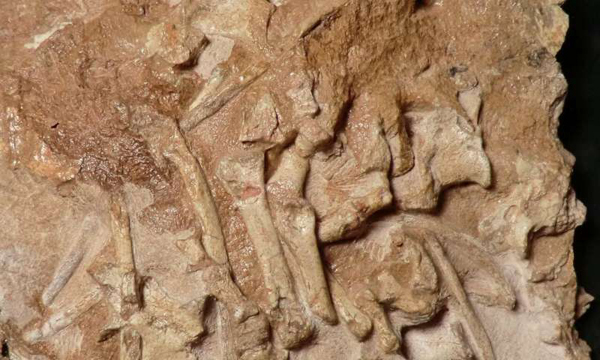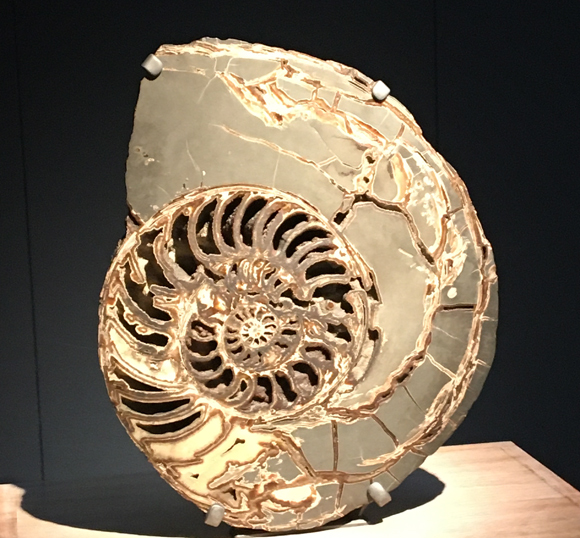Antarctanax shackletoni – Rise of the Archosaurs
A team of researchers, including scientists from the Field Museum (Chicago, USA), the University of Witwatersrand (South Africa) and the Burke Museum (University of Washington, USA), have published a scientific paper announcing the discovery of an archosauriform archosauromorph, that roamed Antarctica in the Early Triassic. The fossil discovery suggests that early archosaurs were more geographically widespread than previously thought and demonstrates that the biota of Antarctica may have been very different from other parts of the super-continent Pangaea as the planet recovered from the End-Permian mass extinction event.
A Diverse Fauna in Antarctica During the Early Triassic
Picture credit: Adrienne Stroup (Field Museum, Chicago)
The illustration above depicts a typical ecosystem that existed in Antarctica approximately 250 million years ago.
Along the banks of a river, three archosaur inhabitants of the dense Voltzia conifer forest cross paths, Antarctanax shackletoni attempts to sneak up on an early titanopetran insect, an archosauromorph Prolacerta rests on a log, and an enigmatic large archosaur pursues two unsuspecting dicynodonts, (Lystrosaurus maccaigi).
“Antarctic King” – Antarctanax shackletoni
Commenting on the significance of the discovery of the iguana-sized animal, co-author of the scientific paper Brandon Peecook (Field Museum) stated:
“This new animal was an archosaur, an early relative of crocodiles and dinosaurs. On its own, it just looks a little like a lizard, but evolutionarily, it’s one of the first members of that big group. It tells us how dinosaurs and their closest relatives evolved and spread.”
The fossil skeleton is far from complete. The material was collected from a site representing Lower Fremouw Formation deposits in the central Transantarctic Mountains. The fossils consist of cervical and dorsal vertebrae, a single humerus and foot bones. The reptile has been named Antarctanax shackletoni. The genus name means “Antarctic King”, although this ancient, basal member of the group of reptiles that was to give rise to the dinosaurs, pterosaurs, crocodiles and birds, was probably not an apex predator. This cannot be stated with certainty, after all, only one fossil specimen has been found, but Antarctanax shackletoni co-existed with a number of other vertebrates including amphibians, synapsids and at least one large archosauriform, which may have been the top predator.
The species name honours the polar explorer Ernest Shackleton. It is suggested that Antarctanax hunted insects as well as smaller vertebrates.
Antarctanax – Where it Lived and When
Brandon Peecook, a member of the Integrative Research Centre, at the Field Museum explained that this fossil find (made in the 2010/11 field season), is significant because it demonstrates that the ecosystem in Antarctica bounced back relatively quickly after the End-Permian mass extinction event and that archosauriforms were quite widespread at this time.
He stated:
“The more we find out about prehistoric Antarctica, the weirder it is. We thought that Antarctic animals would be similar to the ones that were living in southern Africa, [Karoo Basin biota] since those landmasses were joined back then, but we’re finding that Antarctica’s wildlife is surprisingly unique.”
The fauna of the Lower Fremouw Formation traditionally has been considered to represent a subset of the Lystrosaurus Assemblage Zone of the Karoo Basin of southern Africa, with discrepancies largely a result of pronounced differences in sampling intensity. However, a review of recent changes to the fauna, as well as a reassessment of occurrences based on older literature, indicates that significant discrepancies, including the co-occurrences of taxa known from both earlier and later in time and the presence of endemic forms in Antarctica, exist between the faunas of the Lystrosaurus Assemblage Zone and Lower Fremouw Formation.
In essence, Antarctica 250 million years ago had a different ecosystem to that associated with the contemporaneous Karoo Basin deposits.
A Slab of Rock Containing Exposed Post-cranial Material Attributed to Antarctanax shackletoni
Picture credit: Brandon Peecook, Field Museum
As life on Earth recovered in the Early Triassic, so the archosaurs rapidly diversified and laid the foundation for the evolution of the Dinosauria, Pterosauria, crocodiles and those other archosaurs still very much with us today – the Aves (birds).
Post-doctoral Fellow Peecook, went on to state:
“Before the mass extinction, archosaurs were only found around the Equator, but after it, they were everywhere. Antarctica had a combination of these brand-new animals and stragglers of animals that were already extinct in most places, what palaeontologists call ‘dead clades walking.’ You’ve got tomorrow’s animals and yesterday’s animals, co-habiting in a cool place.”
The fact that scientists have found Antarctanax helps bolster the idea that Antarctica was a place of rapid evolution and diversification after the mass extinction.
A spokesperson from Everything Dinosaur commented:
“Antarctica is an extremely difficult part of the world to prospect for fossils. However, as more of the frozen continent is mapped and explored, so more fossil discoveries are going to occur. Antarctanax shows that there was a diverse faunal assemblage on this part of Pangaea during the Early Triassic and this discovery will help palaeontologists to plot the evolution and distribution of archosaurs.”
Everything Dinosaur acknowledges the assistance of a press release from the Field Museum (Chicago), in the compilation of this article.
The scientific paper: “A Novel Archosauromorph from Antarctica and an Updated Review of a High-latitude Vertebrate Assemblage in the Wake of the End-Permian Mass Extinction” by Brandon R. Peecook, Roger M. H. Smith and Christian A. Sidor published in the Journal of Paleontology.
Visit the Everything Dinosaur website: Everything Dinosaur.









Leave A Comment